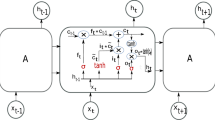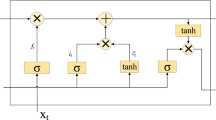Abstract
Electrical load forecasting is a key player in building sustainable power systems and helps in efficient system planning. However, the irregular and noisy behavior in the observed data makes it difficult to achieve better forecasting accuracy. To handle this, we propose a new model, named singular spectrum analysis-long short- term memory (SSA-LSTM). SSA is a signal processing technique used to eliminate the noisy components of a skewed load series. LSTM model uses the outcome of SSA to forecast the final load. We have used five publicly available datasets from the Australian Energy Market Operator (AEMO) repository to assess the performance of the proposed model. The proposed model has superior forecasting accuracy compared to other existing state-of-the-art methods [persistence, autoregressive (AR), AR-exogenous, ARMA-exogenous (ARMAX), support vector regression (SVR), random forest (RF), artificial neural network (ANN), deep belief network (DBN), empirical mode decomposition (EMD-SVR), EMD-ANN, ensemble DBN, and dynamic mode decomposition (DMD)] for half-hourly and one day ahead load forecasting using RMSE and MAPE error metrics.













Similar content being viewed by others
Abbreviations
- AEMO:
-
Australian Energy Market Operator repository
- AR:
-
Autoregressive model
- ARMAX:
-
Autoregressive Moving Average exogenous
- SVR:
-
Support Vector Regression
- RF:
-
Random Forest
- ANN:
-
Artificial Neural Network
- DBN:
-
Deep Belief Network
- EMD-SVR:
-
Empirical Mode Decomposition-Support Vector Regression
- EMD-ANN:
-
Empirical Mode Decomposition-Artificial Neural Network
- EDBN:
-
ensemble Deep Belief Network
- DMD:
-
Dynamic Mode Decomposition
- STLF:
-
Short-Term Load Forecasting
- RBM:
-
Restricted Boltzmann Machines
- IMFs:
-
Intrinsic Mode Functions
- VMD:
-
Variational Mode Decomposition
- SVD:
-
Singular Value Decomposition
- INFS:
-
Integrated Nonlinear Feature Selection
- ANFIS:
-
Adaptive Neuro-Fuzzy Inference System
- SOFM:
-
self-organizing feature map
- \(f_t\) :
-
Forget gate layer of LSTM
- \(i_t\) :
-
Input gate layer of LSTM
- \(C_t\) :
-
Cell state of LSTM
- \(o_t\) :
-
Output gate of LSTM
- \(h_t\) :
-
Final output of LSTM
- Y :
-
Hankel matrix having equal elements on the diagonals
- L :
-
Window size in constructing the Hankel matrix
- EVG:
-
Eigenvalue Grouping
- EV:
-
Eigenvalues
References
Hippert HS, Pedreira CE, Souza RC (2001) Neural networks for short-term load forecasting: a review and evaluation. IEEE Trans Power Syst 16(1):44–55
Zhang G, Patuwo BE, Hu MY (1998) Forecasting with artificial neural networks: the state of the art. Int J Forecast 14(1):35–62
Jain AK, Mao J, Mohiuddin KM (1996) Artificial neural networks: a tutorial. Computer 29(3):31–44
Hinton GE, Osindero S, Teh Y-W (2006) A fast learning algorithm for deep belief nets. Neural Comput 18(7):1527–1554
Laptev N, Yosinski J, Li LE, Smyl S (2017) Time-series extreme event forecasting with neural networks at uber. Int Conf Mach Learn 34:1–5
Salkuti SR (2018) Short-term electrical load forecasting using radial basis function neural networks considering weather factors. Electr Eng 100(3):1985–1995
Liu K, Subbarayan S, Shoults R, Manry M, Kwan C, Lewis F, Naccarino J (1996) Comparison of very short-term load forecasting techniques. IEEE Trans Power Syst 11(2):877–882
Chen D, York M (2008) Neural network based very short term load prediction. In: IEEE/PES transmission and distribution conference and exposition. IEEE 2008, pp 1–9
Qiu X, Zhang L, Ren Y, Suganthan PN, Amaratunga G (2014) Ensemble deep learning for regression and time series forecasting. In: 2014 IEEE symposium on computational intelligence in ensemble learning (CIEL), IEEE, pp 1–6
Qiu X, Ren Y, Suganthan PN, Amaratunga GA (2017) Empirical mode decomposition based ensemble deep learning for load demand time series forecasting. Appl Soft Comput 54:246–255
Lin Y, Luo H, Wang D, Guo H, Zhu K (2017) An ensemble model based on machine learning methods and data preprocessing for short-term electric load forecasting. Energies 10(8):1186
Soliman SA-H, Al-Kandari AM (2010) Electrical load forecasting: modeling and model construction. Elsevier, London
Brockwell PJ, Davis RA (2013) Time series: theory and methods. Springer, Berlin
Huang S-J, Shih K-R (2003) Short-term load forecasting via arma model identification including non-gaussian process considerations. IEEE Trans Power Syst 18(2):673–679
Chen J-F, Wang W-M, Huang C-M (1995) Analysis of an adaptive time-series autoregressive moving-average (arma) model for short-term load forecasting. Electr Power Syst Res 34(3):187–196
Zhang GP (2003) Time series forecasting using a hybrid arima and neural network model. Neurocomputing 50:159–175
Hagan MT, Behr SM (1987) The time series approach to short term load forecasting. IEEE Trans Power Syst 2(3):785–791
De Felice M, Alessandri A, Catalano F (2015) Seasonal climate forecasts for medium-term electricity demand forecasting. Appl Energy 137:435–444
Chen K-Y, Wang C-H (2007) A hybrid sarima and support vector machines in forecasting the production values of the machinery industry in taiwan. Expert Syst Appl 32(1):254–264
Lütkepohl H (2006) Forecasting with varma models. Handbook Econ Forecast 1:287–325
Ceperic E, Ceperic V, Baric A (2013) A strategy for short-term load forecasting by support vector regression machines. IEEE Trans Power Syst 28(4):4356–4364
Pai P-F, Hong W-C (2005) Forecasting regional electricity load based on recurrent support vector machines with genetic algorithms. Electr Power Syst Res 74(3):417–425
Kouhi S, Keynia F (2013) A new cascade nn based method to short-term load forecast in deregulated electricity market. Energy Convers Manag 71:76–83
Li H-Z, Guo S, Li C-J, Sun J-Q (2013) A hybrid annual power load forecasting model based on generalized regression neural network with fruit fly optimization algorithm. Knowl-Based Syst 37:378–387
Kyriakides E, Polycarpou M (2007) Short term electric load forecasting: a tutorial. In: Trends in neural computation, Springer, pp 391–418
Ranaweera D, Hubele N, Papalexopoulos A (1995) Application of radial basis function neural network model for short-term load forecasting. IEE Proc Gener Transm Distrib 142(1):45–50
El-Telbany M, El-Karmi F (2008) Short-term forecasting of jordanian electricity demand using particle swarm optimization. Electr Power Syst Res 78(3):425–433
Cecati C, Kolbusz J, Różycki P, Siano P, Wilamowski BM (2015) A novel rbf training algorithm for short-term electric load forecasting and comparative studies. IEEE Trans Industr Electron 62(10):6519–6529
Çevik HH, Çunkaş M (2015) Short-term load forecasting using fuzzy logic and anfis. Neural Comput Appl 26(6):1355–1367
Fan G-F, Peng L-L, Hong W-C, Sun F (2016) Electric load forecasting by the svr model with differential empirical mode decomposition and auto regression. Neurocomputing 173:958–970
Zhang X, Wang J (2018) A novel decomposition-ensemble model for forecasting short-term load-time series with multiple seasonal patterns. Appl Soft Comput 65:478–494
Fan G-F, Peng L-L, Zhao X, Hong W-C (2017) Applications of hybrid emd with pso and ga for an svr-based load forecasting model. Energies 10(11):1713
Singh P, Dwivedi P (2018) Integration of new evolutionary approach with artificial neural network for solving short term load forecast problem. Appl Energy 217:537–549
Hochreiter S, Schmidhuber J (1997) Long short-term memory. Neural Comput 9(8):1735–1780
Yu R, Zheng S, Anandkumar A, Yue Y Long-term forecasting using tensor-train rnns, arXiv preprint arXiv:1711.00073
Elsner JB, Tsonis AA (2013) Singular spectrum analysis: a new tool in time series analysis. Springer, Berlin
Vautard R, Yiou P, Ghil M (1992) Singular-spectrum analysis: a toolkit for short, noisy chaotic signals. Physica D 58(1–4):95–126
Olah C (2015) Understanding lstm networks, http://colah.github.io/posts/2015-08-Understanding-LSTMs
Golyandina N, Nekrutkin V, Zhigljavsky AA (2001) Analysis of time series structure: SSA and related techniques. Chapman and Hall/CRC, New York
A. energy market operator, AEMO (2013). http://www.aemo.com.au/
Zhang C, Wei H, Zhao J, Liu T, Zhu T, Zhang K (2016) Short-term wind speed forecasting using empirical mode decomposition and feature selection. Renew Energy 96:727–737
Su C-H, Cheng C-H (2016) A hybrid fuzzy time series model based on anfis and integrated nonlinear feature selection method for forecasting stock. Neurocomputing 205:264–273
Huang C-L, Tsai C-Y (2009) A hybrid sofm-svr with a filter-based feature selection for stock market forecasting. Expert Syst Appl 36(2):1529–1539
Hu Z, Bao Y, Xiong T, Chiong R (2015) Hybrid filter-wrapper feature selection for short-term load forecasting. Eng Appl Artif Intell 40:17–27
Koprinska I, Rana M, Agelidis VG (2015) Correlation and instance based feature selection for electricity load forecasting. Knowl-Based Syst 82:29–40
Jiménez F, Palma J, Sánchez G, Marín D, Palacios F, López L (2020) Feature selection based multivariate time series forecasting: an application to antibiotic resistance outbreaks prediction. In: Artificial Intelligence in Medicine 101818
Chollet FK (2015) https://github.com/fchollet/keras
Abadi M, Agarwal A, Barham P, Brevdo E, Chen Z, Citro C, Corrado GS, Davis A, Dean J, Devin M, Ghemawat S, Goodfellow I, Moore S, Murray D, Olah C, Schuster M, Shlens J, Steiner B, Sutskever I, TensorFlow KT (2015) Large-scale machine learning on heterogeneous systems, software available from tensorflow.org. https://www.tensorflow.org/
Cortes C, Vapnik V (1995) Support-vector networks. Mach Learn 20(3):273–297
Haykin S, Network N (2004) A comprehensive foundation. Neural Netw 2(2004):41
Breiman L (2001) Random forests. Mach Learn 45(1):5–32
Lin Y, Peng L (2011) Combined model based on emd-svm for short-term wind power prediction. Proc CSEE 31(31):102–108
Liu H, Chen C, Tian H-Q, Li Y-F (2012) A hybrid model for wind speed prediction using empirical mode decomposition and artificial neural networks. Renew Energy 48:545–556
Mohan N, Soman K, Kumar SS (2018) A data-driven strategy for short-term electric load forecasting using dynamic mode decomposition model. Appl Energy 232:229–244
Demšar J (2006) Statistical comparisons of classifiers over multiple data sets. J Mach Learn Res 7(Jan):1–30
Author information
Authors and Affiliations
Corresponding author
Additional information
Publisher's Note
Springer Nature remains neutral with regard to jurisdictional claims in published maps and institutional affiliations.
Rights and permissions
About this article
Cite this article
Neeraj, N., Mathew, J., Agarwal, M. et al. Long short-term memory-singular spectrum analysis-based model for electric load forecasting. Electr Eng 103, 1067–1082 (2021). https://doi.org/10.1007/s00202-020-01135-y
Received:
Accepted:
Published:
Issue Date:
DOI: https://doi.org/10.1007/s00202-020-01135-y




